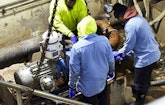The Buffalo Sewer Authority has a real-time sewer overflow map on its website, but it’s doing much more than warning residents about sewer overflows. By 2034, it will have spent nearly a half-billion dollars in a quest to treat every drop of water that enters its combined sewer...
Doing Right by the Environment
Buffalo is on a quest to collect and treat every drop of combined wastewater in its system
Popular Stories
Discussion
Comments on this site are submitted by users and are not endorsed by nor do they reflect the views or opinions of COLE Publishing, Inc. Comments are moderated before being posted.









